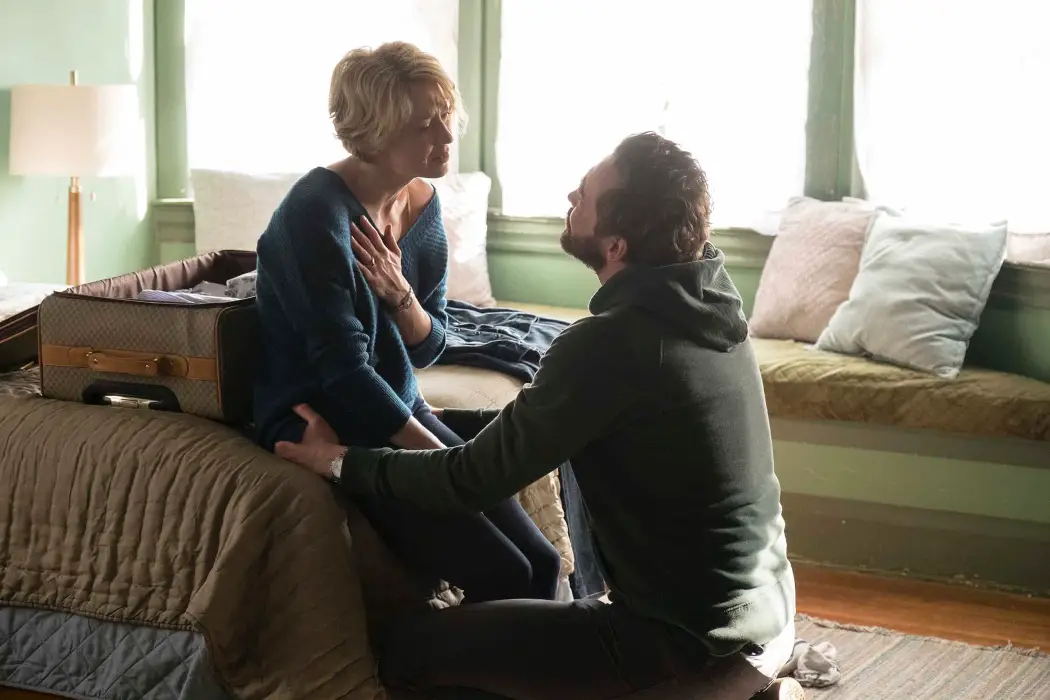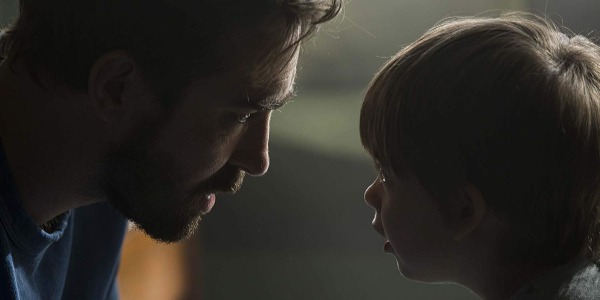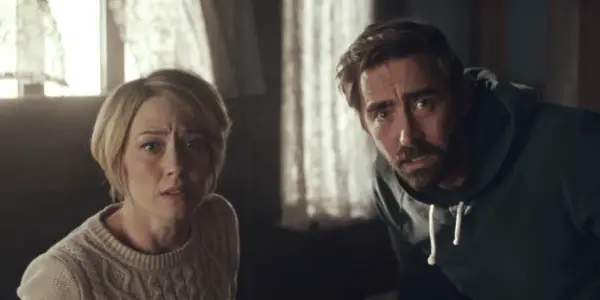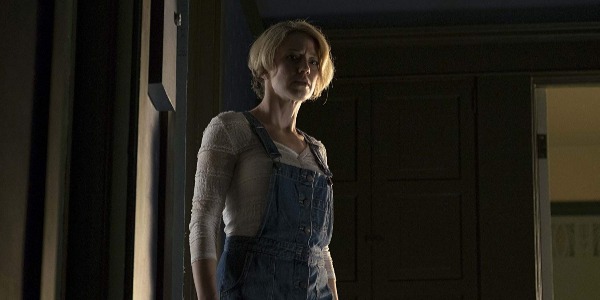THE KEEPING HOURS: Lee Pace & Carrie Coon Keep The Dream Alive

Film critic, Ithaca College and University of St Andrews graduate,…
It’s something of a sick joke to open your horror film with a wedding. A giddy kid (Sander Thomas), television goddess Carrie Coon beaming, and daddy hunk Lee Pace in an adorable bow tie. Enveloping them is a creaky, warm old home in the suburbs, where the sun kisses through the windows.
To spoil the next five minutes of The Keeping Hours would be to ruin one of the film’s richest twists, but I can say regrettably little about the plot until I do: So naturally, we cut to seven years later, with the happy couple now depressed, divorced and down one kid.
That beautiful wooden house from the story’s beginning is now a relic, gone but not forgotten, and instead, Mark (Pace) is living in a cold, sterile apartment, painted in silvers and blacks as if chromium, money and a room with a view can gild over the loss of a child. Mark works one of those generic corporate jobs with an office Jack Lemmon would kill for, but we never actually see him do any work. He’s probably in insurance — most empty, resentful suits in cinema are.
And when Mark visits his ailing, Alzheimer’s-stricken father (Ray Baker), he gently reminds his dad that he and his wife aren’t married anymore, that there’s no Caleb (Thomas) anymore, that nothing’s the way it was before. Remarkably, the scene isn’t hackneyed, as director Karen Moncrieff, whose previous credits include several episodes of 13 Reasons Why and the Christina Ricci – starring Escaping the Madhouse: The Nellie Bly Story, keeps the focus on the characters. We search Mark’s face as he tells his dad about Caleb and Elizabeth (Coon), gauging his lack of feeling, wondering how many times he’s recounted the tragedies of his life to his fading father, how many times he’s unearthed the past in that dark room in the senior home.
The Keeping Hours is a ghost story, but it’s less along the brand lines of The Haunting of Hill House and closer to, well, A Ghost Story. Mostly, it calmly rides the performances to the end of the line, seemingly anemic to anything approaching bombast. The film’s wholly uninterested in being scary, and the early “scare” scenes are seemingly there out of genre obligation rather than any genuine inclination to terrify.
Barely In The Big Blumhouse
Blumhouse Productions has the perfect business model: Give 10 movies and creators a couple million bucks each and let them build their visions, then if even one film is good enough to turn a major profit — Ma or Get Out, for example — the success is inevitably enough to scaffold the nine duds.

Hell, not even all of those duds make it to theaters. The lousy ones and the audience-unfriendly ones get dumped on Netflix, sometimes to garner word-of-mouth with ballsy, risqué and properly creepy content (as with Cam, about cam girls) and sometimes to fester and putrefy like an animal corpse in the shade (Mercy Black, anyone?).
The Keeping Hours, a Blumhouse joint, unfortunately falls in the “audience-unfriendly” crossfires. Where the company has become an auteur-like entity synonymous with good, cheap thrills, The Keeping Hours just isn’t scary enough to live up to Blumhouse’s horror brand. It’d turn belly-up after its wide-release opening weekend, so straight to Netflix it goes with a solid up-front price tag and the hopes that someone somewhere will take a chance on it.
Those who do will be treated to a pensive, slow-moving story told almost as a play might be — mostly in one location, around three actors, forgoing style and punch to instead mine the depths of the human soul. The writer is Rebecca Sonnenshine. The Keeping Hours is written and directed by women, and it’s good, yet it’s been relegated to the Netflix aether to be forgotten. For shame.
My Son Is Ghosting Me
The story is simple, lo-fi stuff, with nary a special effect in sight — which is odd, as one expects a low-budget ghost story to live or die by its effects. What’s going to levitate, who’s going to have black CG eyes, and what gore will there be? The Keeping Hours never goes down that horror film trail, instead taking the path of the trauma drama.

The ghost central to the story is that of Caleb, the dead boy — but Caleb doesn’t hover 3 feet off the ground, doesn’t materialize out of the wall and doesn’t speak with grotesque voice modulation. He is, for all intent and purposes, the same old Caleb, and when Mark sees his son again, it’s clear the only threat at play is the danger of unresolved emotions.
The camera and cinematographer Anastas N. Michos constantly pitch over following their characters. Frequent canted angles trace the graceful slopes of Pace and Coon’s faces, and tighter, closer shots force us to put ourselves in their shoes. For most of the film, the camera wanders, not unlike a ghost itself, a disembodied floating record-keeper.
At first, the spectral shenanigans of The Keeping Hours appear to be a straightforward, simple metaphor for grief and loss, but when Mark hooks his ex-wife, Elizabeth (Coon), into the ghoulish surprise, they make the necessary arrangements: Elizabeth will spend time with him every weekday, and Mark gets the nights and weekends. I haven’t ever seen a ghost-kid-as-divorce allegory before, and it’s thrilling to watch Moncrieff and Sonnenshine build to it.
There’s terror to watching Elizabeth rediscover her son, sitting on the same bed he sat on seven years ago. She can’t touch him, instead brushing up against some sort of force-field bubble. Ghost shit, I suppose. But Coon’s face goes from dread to relief where we might have expected shock. All the fear leaves her, her expression overcome with love. Her boy’s back.
They See Dead People
I’d imagine The Keeping Hours was a bare-bones production scrappily shot in a couple weeks, and for veteran television idols Coon and Pace, it was probably a breeze, akin to a light jog between marathons or cooking breakfast between shifts at a Michelin-star restaurant. Pace has long been a bona fide leading man on TV with Pushing Daisies and Halt and Catch Fire, while Coon has the grief department cornered with her work on The Leftovers and Fargo.

Despite impressive CVs, they give this little, low-budget pic their all, and the fierce dedication of their performances sails the ship through rough waters. They’re brilliant here. Watching them navigate their fraught relationship, I remarked that they could have done the film without dialogue and still nailed the scene.
They unfortunately have to contend with Thomas, who, while not a bad actor by any means, has the unkind task of being both precocious and a Looper-esque telepathic murder child. Caleb’s supposed to be a powder keg of spectral shit waiting to burst; not even the characters know what he’s capable of if he gets really angry. Will he blow the house up? Open a portal to Hell? Bankroll a Truth or Dare sequel?
Not even the sassiest medium/dog-walker in Los Angeles, Janice (Ana Ortiz, another TV star — this time of Ugly Betty), can tell what’s going on. She and Mark meet at a taco truck to discuss Mark’s ghost kid. You know, typical LA stuff.
Janice, with all her character’s quirks, quickly takes the limelight. Firstly, she’s a fashion icon, with her denim jacket, boots, blue hair streak, lava-red lipstick and crucifix necklace, but as the voice of reason, she also delivers some of the film’s best zingers: “I don’t know what you want from me,” she tells Mark during a house call. “I told you to send him back. But did you do that? No. You’re playing house with him.”
The Keeping Hours: Conclusion
Coon read a book, Wave, on the set of The Leftovers. The story, by Sonali Deraniyagala, details a family wrenched apart by a tsunami in 2004, and Coon would later talk about how every page of the book helps her to immerse herself into the dark, mournful series.
Watching The Keeping Hours, I thought of Wave when Coon falls in love again with her child and as everyone meanders closer to the denouement, when you know the genie’s going to have to be put back into the bottle. Your son returns from beyond the grave but doesn’t have long to stay — you’d be sobbing too.
What’s your favorite little-seen Blumhouse movie? Let me know in the comments below!
Watch The Keeping Hours
Does content like this matter to you?
Become a Member and support film journalism. Unlock access to all of Film Inquiry`s great articles. Join a community of like-minded readers who are passionate about cinema - get access to our private members Network, give back to independent filmmakers, and more.
Film critic, Ithaca College and University of St Andrews graduate, head of the "Paddington 2" fan club.












